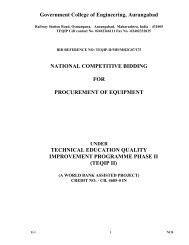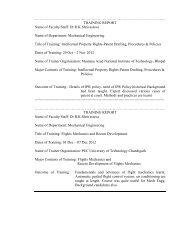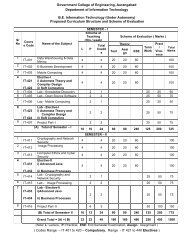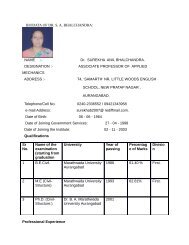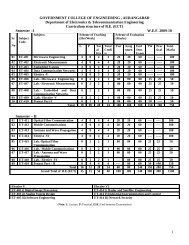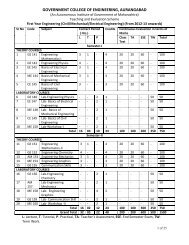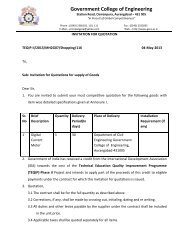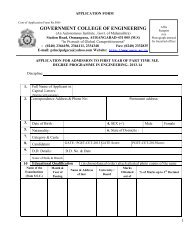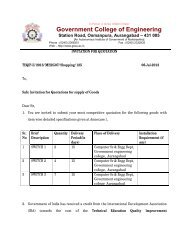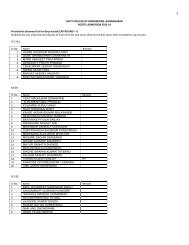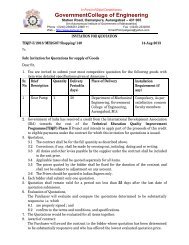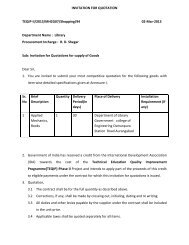Ph.D. Information Brochure 2013-14 - Government College Of ...
Ph.D. Information Brochure 2013-14 - Government College Of ...
Ph.D. Information Brochure 2013-14 - Government College Of ...
You also want an ePaper? Increase the reach of your titles
YUMPU automatically turns print PDFs into web optimized ePapers that Google loves.
“In Pursuit of Global Competitiveness”<br />
INFORMATION BROCHURE<br />
FOR<br />
ADMISSION TO <strong>Ph</strong>.D. PROGRAMMES <strong>2013</strong>‐<strong>14</strong><br />
<strong>Government</strong> <strong>College</strong> of Engineering<br />
Osmanpura, Station Road, Aurangabad ‐ 431 005<br />
Maharashtra State, India<br />
(An Autonomous Institute of Govt. of Maharashtra)<br />
<strong>Ph</strong>one: (0240) 2366<strong>14</strong>0, 2366160, 2366181, 2366150, 2366221, 2366251,2366111<br />
Fax:(0240) 2332835, E‐mail: principalgeca@yahoo.com<br />
Web‐Site: www.geca.ac.in<br />
1 of 18
1. HISTORY<br />
GOVERNMENT COLLEGE OF ENGINEERING<br />
AURANGABAD‐431 005<br />
The institute has been established in 1960 to meet the growing demand for technical man power<br />
in the state of Maharashtra. The <strong>Government</strong> <strong>College</strong> of Engineering, Aurangabad is one of<br />
the renowned institute in Maharashtra and its establishment has fulfilled the aspirations of people<br />
of Marathwada region. Initially the institute offered UG programs in three core branches<br />
of engineering viz. Civil, Mechanical and Electrical, with intake capacity of 60 students per branch,<br />
leading to Bachelors degree of Engineering in respective disciplines. Subsequently additional UG<br />
programs such as Electronics and Telecommunications, Computer Science and engineering (1986)<br />
and <strong>Information</strong> Technology (2000), have been added. Post‐graduate programs leading to Masters<br />
degree in Engineering have been introduced in 1986. Institute is functioning as an autonomous<br />
Institute affiliated to Dr. Babasaheb Ambedkar Marathwada University, Aurangabad from<br />
academic year 2006‐07. The institute has started <strong>Ph</strong>.D. programmes in four disciplines of<br />
Engineering/Technology in 2006 and one discipline in 2010 and has registered around 95 <strong>Ph</strong>.D.<br />
candidates. The University has conferred the status of autonomous college to all U.G., P.G. and<br />
<strong>Ph</strong>.D. programs of the institute.<br />
2. THE INSTITUTE:<br />
Institute is situated in the heart of Aurangabad city at about 1 Km from railway station, sprawling<br />
over a campus of around 22 acres with separate buildings for various Programmes, Departments,<br />
Library, Auditorium, Workshop, Hostels and <strong>Of</strong>fice. Auditorium of the institute has a seating<br />
capacity of about 1000 persons. The institute has well furnished and equipped Seminar and<br />
conference facilities. The institute offers hostel facilities to male students (400) and female<br />
students (120). With the funding support from Govt. of Maharashtra, World‐Bank assisted TEQIP‐<br />
2 of 18
<strong>Ph</strong>ase‐I Program and AICTE; laboratories are equipped with modern equipments and machinery to<br />
enhance practical knowledge of the students. The institute has been selected for funding under<br />
TEQIP‐<strong>Ph</strong>ase‐II also, during which the focus will be on PG, <strong>Ph</strong>.D. programmes, research and<br />
development activities. Each department has separate computer laboratory adequate numbers of<br />
PCs with internet gateway connectivity and required application software. Central library has a<br />
seating capacity for 200 readers with separate seating arrangement for faculty members. There<br />
are more than 67435 text and reference books and bound volumes of technical journals. <strong>College</strong><br />
has also subscribed to online journals of high repute. Institute has very senior and experienced<br />
teaching faculty and supporting staff devoted to teaching and students welfare. Faculty is actively<br />
involved in research, development, testing, consultancy and publication of research papers and<br />
books. All Doctoral Programs leading to <strong>Ph</strong>.D. degree will be offered under autonomy & will be<br />
governed by Rules & Regulations framed by the institute authorities. These rules can be<br />
downloaded from institute website www.geca.ac.in.<br />
3. DOCTORAL PROGRAMMES:<br />
The institute offers doctoral programmes leading to <strong>Ph</strong>.D. degree in Engineering/Technology in the<br />
following disciplines<br />
S. No. DISCIPLINE /BRANCH YEAR OF STARTING<br />
1 <strong>Ph</strong>.D. (Civil Engineering) 2006<br />
2 <strong>Ph</strong>.D. (Structural Engineering) 2006<br />
3 <strong>Ph</strong>.D. (Mechanical Engineering) 2006<br />
4 <strong>Ph</strong>.D. (Electrical Engineering) 2006<br />
5 <strong>Ph</strong>.D. (Electronics Engineering) 2010<br />
3 of 18
RULES FOR ADMISSION TO <strong>Ph</strong>.D. DEGREE IN ENGINEERING/TECHNOLOGY DURING THE<br />
ACADEMIC YEAR ‐<strong>2013</strong>‐<strong>14</strong><br />
1. GENERAL<br />
• The competent authority for admissions to all the Doctoral programmes shall be the<br />
Principal of the institute.<br />
• All the <strong>Ph</strong>.D. programmes are run by the autonomous institute, <strong>Government</strong> <strong>College</strong><br />
of Engineering, Aurangabad, affiliated to Dr. Babasaheb Ambedkar Marathwada<br />
University Aurangabad and are approved by AICTE.<br />
• Valid GATE Score means it must satisfy two conditions: One is valid time period and<br />
second is qualifying marks.<br />
• All the <strong>Ph</strong>.D. programmes shall be governed by the rules and regulations framed<br />
by the autonomous institute (Refer www.geca.ac.in) in concurrence with UGC<br />
guidelines.<br />
2. ADMISSIONS TO <strong>Ph</strong>.D. PROGRAMMES<br />
2.1 Seats Available: The number of seats available in the institute depend on the number of<br />
available research guides in the institute and the vacancies available with the guides and are<br />
subject to variations. The admission of candidates to <strong>Ph</strong>.D. programmes depends on the<br />
expertise available in a department and the willingness of the candidate and the guide to<br />
work in the corresponding research areas.<br />
2.2 Eligibility for Admission:<br />
A candidate can apply for admission to <strong>Ph</strong>.D. programme if he/she satisfies the following<br />
conditions provided he/she has not registered for <strong>Ph</strong>.D. or any other course at any<br />
other institute/University:<br />
A) Passed Bachelor’s and Master’s degree examination in appropriate discipline (as given<br />
in Appendix‐A of this brochure) of Engineering /Technology of this institute or from<br />
affiliating university or any other recognized universities.<br />
OR<br />
A candidate who applies for registration on the basis of his/her research work leading<br />
to Master’s degree (M.E./M.Tech by research) in Relevant discipline of<br />
Engineering/Technology should have at least 60 percent of aggregate marks or<br />
equivalent grade points of recognized institute/ university relevant with the subject,<br />
and shall have passed the Bachelor’s degree in examination in appropriate discipline<br />
with not less than 60 percent marks or equivalent grade points.<br />
AND<br />
B)<br />
4 of 18
(i) He/She must have minimum of 60% marks or equivalent at the Post Graduate<br />
examination. Candidate belonging to SC/ST category or physically challenged<br />
/disabled candidates shall be given relaxation of 5%.<br />
(ii) A Part‐time candidate desirous of registration to <strong>Ph</strong>.D. who is working in any<br />
registered organization/institution/firm/company/industry should submit NOC<br />
from the employer along with the application form.<br />
2.3 Reservation<br />
The reservations will be as per the reservation policy of the <strong>Government</strong> of Maharashtra.<br />
Head of the Institute shall be the final authority for seat distribution.<br />
2.4 Admission/Selection Procedure :<br />
(i) The desirous candidates are required to apply for admission to <strong>Ph</strong>.D. programme in the<br />
prescribed format with all the necessary documents. The selection process for admission to<br />
<strong>Ph</strong>.D. programme shall be in two stages.<br />
Stage‐I: All the candidates applied for admission to <strong>Ph</strong>.D. programme are required to<br />
qualify in a written examination in the relevant discipline conducted by the institute. The<br />
syllabi for the written test is as given in Appendix‐B of this brochure. The entrance test shall<br />
be of duration 2 Hrs for 70 marks consisting of objective questions in the relevant discipline.<br />
The qualifying marks in entrance test shall be 28 marks (40%). Those who qualify in the<br />
entrance test shall only be eligible for Stage‐II.<br />
Stage‐II: The candidates who qualify in the written test shall appear for a presentation and<br />
interview before the duly constituted evaluation committee. The presentation/interview<br />
shall be for 30 marks.<br />
The candidate has to obtain a minimum of 50 marks in stageI and II together (50%) for<br />
qualifying for admission to <strong>Ph</strong>.D. programme. However obtaining qualifying marks does not<br />
entitle the candidate for admission to <strong>Ph</strong>.D. program.<br />
(ii) A candidate having a valid GATE score in the relevant discipline is exempted from the<br />
written test. However he has to appear for presentation/interview and obtain a minimum of<br />
15 marks (50%) for qualifying for admission. His /her score in the presentation and interview<br />
converted to 100 marks shall be considered for his/her position in the merit list.<br />
iii) The presentation should be brief and clear (around 5‐10 minutes) highlighting the basic<br />
idea of proposed work. The presentation can broadly include (but not restricted to)<br />
1. The topic/subject of the proposed research work.<br />
2. An outline containing introduction to the subject, international/national<br />
importance, broad objectives, scope of the thesis and methodology/stages of<br />
research work with relevant literature review;<br />
3. For Part‐time candidate, the normal place where he/she proposes to carry out<br />
his/her research work after successful completion of credit courses.<br />
5 of 18
2.5 Relevant Certificates<br />
Attested copies of following documents/certificates should be attached with the<br />
application form.<br />
• All the candidates should attach attested photocopies of relevant documents related to his<br />
educational qualification/s and experience as claimed in the application form.<br />
• The employed candidates should attach a NOC from the employer in the prescribed format (For<br />
Part‐time candidates)<br />
• All the candidates will be required to produce a Nationality Certificate.<br />
• Candidates claiming to belong to backward class will be required to produce a certificate to<br />
that effect from appropriate authority in addition to Nationality Certificate. Candidates<br />
belonging to categories SC, ST, VJ/DT/NT(A), NT(B), NT(C), NT(D), OBC, and SBC, will be<br />
required to produce a Caste Certificate, Caste/Tribe Validity Certificate and valid<br />
Non‐Creamy layer certificate (if applicable).<br />
• Nationality Certificate:‐<br />
The Certificate of Indian Nationality is a part of the Domicile Certificate, which is usually<br />
issued by the Tahshildar/Executive Magistrate/Dy. Collector of the concerned District/Taluka.<br />
In lieu of this “Certificate of Indian Nationality” following Certificates/Documents will also be<br />
acceptable‐<br />
1. Indian Passport in the name of the Candidate, issued by appropriate authorities.<br />
2. The School Leaving Certificate indicating the Nationality of the Candidate as<br />
‘Indian’.<br />
3. Birth Certificate of the Candidate indicating the Place of birth of the Candidate is<br />
within India.<br />
If the Indian Resident Candidate fails to produce any one of the above mentioned<br />
certificate/documents indicating Nationality then such candidates Nationality shall be<br />
considered based on the undertaking given in Proforma‐I on Rs. 100 Non‐Judicial Stamp Paper<br />
at the time of submission of Application form for admission.<br />
• Caste Validity Certificate:‐<br />
Candidates belonging to SC, ST, VJ/DT NT (A), NT (B), NT(C), NT(D), OBC, and SBC category<br />
are required to produce Caste Validity Certificate at the time of filling of the application form.<br />
• Non‐Creamy Layer Certificate:‐<br />
A candidate belonging to ‘Creamy Layer’ amongst the categories SBC, V.J./D.T./N.T.(A),<br />
N.T.(B), N.T.(C), N.T.(D) and O.B.C. must note that the provision of reservation is NOT<br />
applicable to him/her. A candidate claiming benefit of reservation under the categories SBC,<br />
V.J./N.T.(A), N.T.(B), N.T.(C), N.T.(D) and O.B.C. will be required to produce “Non‐Creamy Layer<br />
Certificate” in the name of the candidate as specified in the <strong>Government</strong> Resolution No.<br />
CBC/10/2008/CR‐697/BCW‐5, dated 27th February 2009 or its updated versions from time to<br />
st<br />
time. The certificate must be valid up to 31 March 20<strong>14</strong>.<br />
6 of 18
• The candidate claiming to be physically handicapped shall produce a certificate, in the<br />
prescribed Proforma‐F, from the Director, All India Institute of <strong>Ph</strong>ysically Handicapped,<br />
Mumbai or Dean/Civil Surgeon of the <strong>Government</strong> / CIVIL HOSPITALS normally located at the<br />
District Headquarters, regarding his or her physical disability, and ability to undergo all parts of<br />
syllabus for the normal course. Candidates suffering from Dyslexia, Dysgraphica & Dyscalculia<br />
are required to produce certificate (Proforma‐F1) issued by the ‘Learning Disability Clinic,<br />
Lokmanya Tilak Municipal General Hospital, Sion, Mumbai‐22’.<br />
2.6 Stipend/Scholarships:<br />
Teaching and Research Assistantship will be provided for Full Time Non sponsored candidates only<br />
under World Bank assisted TEQIP‐II project. All the non sponsored candidates pursuing full time<br />
<strong>Ph</strong>.D. programmes are entitled to receive amount of fellowship of Rs. 18000/‐ per month for the<br />
first and second year .While the candidates are entitled to receive amount of fellowship of Rs.<br />
20000/‐ for third year. These assistantships are offered under TEQIP‐II project and are subject to<br />
approval from the authorities and availability of funds before the closure of the project. The closing<br />
date of TEQIP‐II is 31 st December, 20<strong>14</strong>.<br />
No candidate selected under part‐time/externally registered category/sponsored shall receive any<br />
scholarship/stipend.<br />
3. FEES<br />
• Presently the fees are Rs. 48260/‐ per year plus other charges as applicable. In addition, the<br />
institution may charge other fees applicable as approved by the institute authorities.<br />
• The fees are to be paid in full every year till the submission of final synopsis of the <strong>Ph</strong>.D. work.<br />
• The fees are to be paid in full by all the selected candidates including the reserved category<br />
candidates.<br />
4. CANCELLATION OF ADMISSION AND REFUND OF FEES<br />
Fees paid by the candidate shall be refunded to him after deducting cancellation charges<br />
of Rs. 1000/‐ (Rs One Thousand only) if the admission is cancelled before the last date for<br />
taking admission, which will be notified by the institute. If the seat is cancelled after the last<br />
date of admission, no fees shall be refunded.<br />
5. CONDUCT AND DESCIPLINE<br />
5.1 General<br />
• Students while studying in any Engineering / Technology Institute, if found indulging in<br />
anti‐national activities contrary to the provisions of acts and laws enforced by <strong>Government</strong><br />
from time to time, any activity contrary to rules of discipline will be liable to be<br />
expelled from the institute without any notice by the Principal /Director of the institute.<br />
• Candidates applying for admission against the seats reserved for backward classes<br />
mentioned in these Rules should note that only those candidates who actually belong<br />
to the castes and communities will be eligible for the benefits.<br />
• If any of the statement made in application form or any information supplied by the<br />
candidate in connection with his/her admission is later on, at any time, found to be false or<br />
7 of 18
incorrect, his/her admission will be cancelled, fees forfeited and he/she may be<br />
expelled from the college by the Principal/Director and prosecuted, if deemed necessary.<br />
An appeal against the order of expulsion, however, may be referred to the Joint Director of<br />
Technical Education of respective region whose decision in such cases will be final and<br />
binding on all concerned.<br />
• All the candidates registered for Doctoral degree should note that violation of any copyright/patent<br />
rights/IPR or duplication of any work during the <strong>Ph</strong>.D. work is liable for<br />
prosecution and will be expelled from the institute immediately.<br />
5.2 Action against ragging: Maharashtra Prohibition of Ragging Act 1999 and Prevention and<br />
Prohibition of Ragging (Appendix 12 published in AICTE Approval Process Handbook 2011‐12)<br />
and their amendments which may be published from time to time. The Maharashtra<br />
Prohibition of Ragging Act 1999 is in effect from 15th May, 1999 has the following<br />
provisions for Action against Ragging.<br />
a) Ragging within or outside of any educational institution is prohibited,<br />
b) Whosoever directly or indirectly commits, participates in, abets, or propagates ragging<br />
within or outside any educational institution shall, on conviction, be punished with<br />
imprisonment for a term up to 2 years and / or penalty, which may extend to ten thousand<br />
rupees.<br />
c) Any student convicted of an offence of ragging shall be dismissed from the educational<br />
institution and such student shall not be admitted in any other educational institution for a<br />
period of five years from the date of order of such dismissal.<br />
d) Whenever any student or, as the case may be, the parent or guardian or a teacher of an<br />
educational institution complaints, in writing, of ragging to the head of the educational<br />
institution, the head of the educational institution shall, without prejudice to the foregoing<br />
provisions, within seven days of the receipt of the complaint, enquire into the matter<br />
mentioned in the complaint and if, prima facie, it is found true, suspend the student who is<br />
accused of the offence, and shall, immediately forward the complaint to the police station<br />
having jurisdiction over the area in which the educational institution is situated, for further<br />
action. Where, on enquiry by the head of the educational institution, it is found that<br />
there is no substance, prima facie, in the complaint received, he / she shall intimate the<br />
fact, in writing, to the complainant. The decision of the head of the educational institution<br />
shall be final.<br />
e) If the Head of the educational institution fails or neglects to act in the manner specified in<br />
section “d” above when a complaint of ragging is made, such person shall be deemed<br />
to have abetted the offence and shall, on conviction, be punished as provided for in<br />
section “b” above.<br />
5.3 Undertaking<br />
All candidates for admission to <strong>Ph</strong>.D. program in Engineering/Technology are required to give an<br />
undertaking as given in Proforma‐I :‐<br />
8 of 18
Proforma – F<br />
(To be issued on the Printed Letter Head of the concerned office)<br />
<strong>Ph</strong>otograph<br />
(For P1/ P2/ P3 Candidates)<br />
of the<br />
candidate<br />
(For <strong>Ph</strong>ysically Handicapped Candidates)<br />
showing the<br />
<strong>Ph</strong>ysical<br />
CERTIFICATE<br />
Disability<br />
This is to certify that I have examined Mr. / Miss …………………………………….. …………………………… on<br />
………………………. He / She has …………………………………(Name of the <strong>Ph</strong>ysical Disability) which comes<br />
under the sub category Blindness (P1)/Speech & Hearing impaired(P2)/Orthopedic disorder (P3)<br />
Certified that:<br />
1 The percentage of handicap is not less than 40% and is equal to ……………………………….%.<br />
2 The disability is permanent in nature.<br />
3 The candidate is capable of carrying out all activities related to theory and practical works<br />
as applicable to Doctoral Degree course in Engineering / Technology without any special<br />
concessions and exemptions.<br />
4 This Certificate is issued as per the provisions given in the Person with Disability Act, 1995<br />
and its amendments.<br />
This certificate is issued for the purpose of his/her admission to First Year of Doctoral Degree<br />
course in Engineering / Technology in Maharashtra for the academic year .<br />
Outward No. & Date:<br />
Place :<br />
(Name & Signature)<br />
Director, All India Institute of <strong>Ph</strong>ysically Handicapped, Mumbai<br />
Seal of the <strong>Of</strong>fice<br />
Or<br />
Dean/Civil Surgeon of <strong>Government</strong> Hospital<br />
(Name of the issuing Authority)<br />
9 of 18
Proforma–F‐1<br />
(To be issued on the Printed Letter Head of the concerned office)<br />
Name :<br />
Age :<br />
Date of Birth :<br />
Date of Registration :<br />
L.D.No.<br />
Father’s Name :<br />
Std. :<br />
School Name :<br />
<strong>Ph</strong>ysical & Neurologic Assessment Date :<br />
Psychologic Assessment Date :<br />
(For <strong>Ph</strong>ysically Handicapped Candidates)<br />
LEARNING DISABILITY CLINIC<br />
L.T.M.G. HOSPITAL, SION, MUMBAI‐400 022.<br />
CERTIFICATE<br />
WISC ( R ) Verbal<br />
IQ : Performance<br />
IQ : Global IQ :<br />
Interpretation :<br />
Educational Assessment Date:<br />
WRAT: R<br />
S<br />
A<br />
Certified that:<br />
1 The percentage of handicap is not less than 40% and is equal to ………..………..%.<br />
2 The disability is permanent in nature.<br />
3 The candidate is capable of carrying out all activities related to theory and practical works<br />
as applicable to Doctoral Degree in Engineering / Technology without any special concessions and<br />
exemptions.<br />
4 This Certificate is issued as per the provisions given in the Person with Disability Act, 1995<br />
and its amendments.<br />
This certificate is issued for the purpose of his/her admission to First Year of Doctoral Degree<br />
course in Engineering / Technology in Maharashtra for the academic year .<br />
Recommendations:<br />
Outward No. & Date:<br />
(Name and Signature of Issuing Authority)<br />
Seal of the <strong>Of</strong>fice<br />
10 of 18
Proforma‐ I<br />
UNDERTAKING<br />
(To be submitted at the time of submission of Application Form)<br />
(Strike out whichever is not applicable)<br />
a) I…………………………………………………………….(Name of the Candidate) herewith undertake that I<br />
have read all the Rules of Admission to <strong>Ph</strong>.D. for the year 2012‐<strong>2013</strong> and after fully<br />
understanding all the rules, I have filled in this application form for admission for the current<br />
academic year.<br />
b) I am a citizen of India or I am a Citizen of /Foreign National<br />
c) The information given by me in my application form is true to the best of my knowledge and<br />
belief.<br />
d) If at later stage, it is found that I have furnished wrong information and/or submitted false<br />
certificate(s), I am aware that my admission stands cancelled and fees paid by me will be<br />
forfeited. Further I will be subject to legal and/or penal action as per the provisions of the law.<br />
e) I have not been debarred from appearing at any examination conducted by any <strong>Government</strong><br />
constituted or statutory autonomous examination authority in India.<br />
f) I fully understand that the offer of allotment will be made to me depending on my inter‐se<br />
merit, options given by me and availability of seats at that point of time during the process of<br />
allotment.<br />
g) I hereby agree to conform to any Rules, Acts and Laws enforced by the <strong>Government</strong> and I<br />
hereby undertake that so long as I shall be a student of the <strong>College</strong> / Institute I will do nothing<br />
either inside or outside the <strong>College</strong> / Institute which may result in compelling the authorities<br />
to take disciplinary action against me under the rules, acts, and laws of good conduct and<br />
behavior in general and particularly those rules of good conduct and discipline prescribed by<br />
the Institute / <strong>College</strong> / University / <strong>Government</strong> (if any) from time to time.<br />
h) I fully understand that the Principal of the Institute where I shall be admitted, will have a right<br />
to expel, rusticate me from the <strong>College</strong> / Institution for any infringement of the Rules of good<br />
conduct and discipline in general and particularly those rules of good conduct and discipline<br />
prescribed by the Institute / <strong>College</strong> / University / DTE/ AICTE/ <strong>Government</strong> (if any) from time<br />
to time.<br />
i) I understand that, as a full time candidate, I am not permitted to work/join any<br />
Institute/Firm/Industry for job during the duration of teaching and research assistantship.<br />
Signature of the Candidate<br />
(Name of the Candidate)<br />
11 of 18
Appendix‐A<br />
For admission to <strong>Ph</strong>.D. programme, the required qualification will be Masters Degree and<br />
Bachelors Degree in Engineering in relevant / allied branch of Engineering with minimum 60%<br />
marks or its equivalent at PG level for open category and 55% marks or its equivalent for Reserved<br />
category as given below.<br />
<strong>Ph</strong>.D. Programs in Engineering/Technology<br />
<strong>Ph</strong>.D. (Structural Engineering)<br />
Civil / Civil (Construction) and allied branches of Engineering and Technology<br />
<strong>Ph</strong>.D. (Civil Engineering )<br />
Civil /Civil (Construction) /Civil‐Water Management/ Civil – Environmental Engineering and allied<br />
branches of Engineering and Technology.<br />
<strong>Ph</strong>.D. (Mechanical Engineering)<br />
Mechanical / Production /Production Technology and allied branches of Engineering and<br />
Technology<br />
<strong>Ph</strong>.D. ( Electronics Engineering)<br />
Electronics/ Electronics and Communication / Electronics and Telecommunication /Computer<br />
Engineering / Computer Technology / Computer Science and Technology /Computer Science /<br />
Industrial Electronics / Electronics product Design Technology / Power Electronics /<br />
Instrumentation/<strong>Information</strong> Technology and allied branches of Engineering and Technology<br />
<strong>Ph</strong>.D. ( Electrical Engineering)<br />
Electrical / Electrical (Electronics & Power) / Electronics and Power /Electronics/Instrumentation<br />
and allied branches of Engineering and Technology<br />
*****<br />
12 of 18
Appendix‐B<br />
The Syllabi for the<br />
Entrance Test For<br />
Various<br />
<strong>Ph</strong>.D. Programmes<br />
13 of 18
Syllabus for Entrance Examination<br />
<strong>Ph</strong>.D. ‐ Structural Engineering<br />
(Total marks 70)<br />
Unit‐I: Research Aptitude and Analytical Abilty<br />
(20 Marks)<br />
Analytical modelling, Problem formulation, Reading comprehension, Research proposal, data<br />
sufficiency and data interpretation, Validity and reliability of data, Logical reasoning and computer<br />
awarness<br />
Unit‐II: Strutural Engineering Subject<br />
(50 marks)<br />
1) Theorey of Elasticity and Plasticity (10 Marks)<br />
Plane Stress and Plain Strain, 3‐Dimensional Elasticity, Principal Stresses and Principal Strains,<br />
Octahedral Stresses, Equilibrium, boundary and Compatibility Conditions Generalized Hooke’s Law,<br />
Strain Dispalcement Realationship,<br />
Basic concepts of plasticity, Stress-strain equations, Yield criteria, Flow and deformation<br />
theories- Tresca, Von Mises, St. Venant’s theory of plastic flow, Geometrical representation.<br />
2) Finite Element Anaysis of Structure and Structural Analysis (10 Marks)<br />
Principle of virtual work, minimum potential energy. Rayleigh – Ritz method, General principles of<br />
finite element method, discretization of continuum numbering of nodes for minimum bandwidth,<br />
overall striffness and solution of unknown displacement using Gauss elimination technique,<br />
convergence requirements, compatibility, conforming and non‐conforming elements, shape functions,<br />
Natural coordinate system, Basic elements and Elements for plane stress and plane strain conditions.<br />
Matrix methods of frame analysis. Basic concepts and comparison of Flexibility and<br />
stiffness methods, Multistoried buildings: Portal Method, Cantilever Method, Principle of<br />
multiple and substitute frame method of analysis,<br />
3) Thorey of Plates and Shells (10 Mraks)<br />
Introduction to thin plates under small deflection, Kirchoff’s small deflection theory, Strain<br />
displacement , stress‐displacement and force‐displacement relationships, Rectangular plates, differential<br />
equation, solution of simply supported plates under in plane and lateral loading, Navier and Lavy’s<br />
Solution. Use of Finite difference and finite element method<br />
Classification of shells, Type of surfaces, structural characteristics, geometrical criteria for<br />
different shells. Basic equations of membrane analysis of shells of revolution, circular cylindrical shell,<br />
elliptical, hyperbolic and paraboloidal shells,Bending theory of analysis of shell, Structural behavior of<br />
folded plates, equation of three shears‐ Simpson and Whitney’s method.<br />
4) Design of Steel and Concrete Structures and Concrete Technology (10 Mraks)<br />
<strong>14</strong> of 18
Bolted and welded connection, moment resistant connections, Design of tension and<br />
compression and flexural members, Introduction to limit state design of reinforced concrete, Types and<br />
classification of limit states, Redistribution of moments and its I.S. Code provisions<br />
Types of Cementitious materials, Types and properties of Chemical Admixtures, compatibility<br />
with cement, Natural and Artificial sand, Properties of fresh and hardened concrete, Durability of<br />
concrete, Testing of Concrete: Destructive and nondestructive tests, Methods of Concrete mix<br />
proportioning and their relative merits and demerits. Quality control of concrete, Statistical aspects,<br />
High Performance Concrete: Materials, properties, Mix proportioning, Ready Mix Concrete, Self<br />
Compacting Concrete: Materials, properties, Mix proportioning, Concrete Composite: Various types of<br />
Fibers used in concrete, Law of Mixtures, Halpin‐Tsai Equations for evaluation of elastic constants,<br />
Behavior of Fiber Reinforced Concrete (FRC) in Tension, Compression, Flexure, shear, Fatigue and Impact,<br />
Durability aspects of FRC.<br />
5) Structural dynamics and Earthquake Engineeing<br />
System with single degree of freedom, free and Forced Oscillations, Response of<br />
structures, dynamic application factor, critical, under and over critical damping.<br />
Multi‐degree Freedom Systems: Formulation of problem, structural property matrices. Modal<br />
analysis, Stodola‐ Vianello and Holzer methods. Application to multistory frames with rigid girders.<br />
Elementary concept of earthquakes: Nature of loading due to earthquakes, response of<br />
structures, deterministic and stochastic approach, Earthquake resistant structures: IS Code provisions and<br />
applications to buildings..<br />
Note : The syllabus of structural engineering subjects, is based on all the books at PG level<br />
15 of 18
<strong>Ph</strong>.D. - Civil Engineering<br />
(Total marks 70)<br />
Fluid Mechanics and Water Resources Engineering: Fluid kinematics, Fluid dynamics, Flow<br />
through pipes, Evapo-transpiration, Hydrographs, Confined and unconfined aquifers, Delta, Duty,<br />
Determination of duty, Various methods of applying water to crops and their comparison, Causes<br />
and effects of water logging, Its remedial measures, Gravity dams, Earth dams, Spillways, Canals<br />
Environmental Engineering: Water and wastewater treatment, Air pollution and control,<br />
Industrial waste treatment, Solid waste management<br />
Optimization Techniques: Linear programming, Non linear programming, Dynamic<br />
programming, Simulation<br />
Geotechnical Engineering and Foundation: Properties and classification of soils, Shear strength<br />
parameters of soil and stress distribution in soils, Compaction, Consolidation, Earth pressure and<br />
stability of slopes, Bearing capacity, Pile foundation, Raft foundation<br />
Transportation Engineering<br />
Bridge: Types of bridges, Selection of bridge site, Flood discharge, Water way calculations,<br />
Afflux, scour, River training works Highway: Highway planning and financing, Highway<br />
alignment and geometric design, Highway material soil and its characteristics, Flexible and rigid<br />
pavement, Pavement construction and construction machinery<br />
Construction Management<br />
Construction scheduling and network analysis, Resource and financial management, Project<br />
appraisal and development, Safety engineering, Site layout and Management <strong>Information</strong> System<br />
(MIS), Surveying: Leveling, Theodolite, Contours, <strong>Ph</strong>otogrammetry, Geographical <strong>Information</strong><br />
System and Remote sensing<br />
*****<br />
16 of 18
Syllabus for Entrance Examination<br />
<strong>Ph</strong>.D. – Mechanical Engineering<br />
(Total marks 70)<br />
Linear Algebra,Differential equations: First order equations, Higher order linear differential<br />
equations Initial and boundary value problems, Laplace transforms.<br />
Probability and Statistics: Definitions of probability and sampling theorems. Mean, median, mode<br />
and standard deviation, Random variables<br />
Numerical Methods: Numerical solutions of linear and non-linear algebraic equations Integration<br />
by trapezoidal and Simpsons rule, single and multi-step methods for differential equations.<br />
Strength of Materials: Stress and strain, stress-strain relationship and elastic constants, thin<br />
cylinders; shear force and bending moment diagrams; bending and shear stresses; deflection of<br />
beams; torsion of circular shafts, thermal stresses.<br />
Design: Design for static and dynamic loading; failure theories; fatigue strength and the S-N<br />
diagram; principles of the design of machine elements such as bolted, riveted and welded joints,<br />
shafts, spur gears, rolling and sliding contact bearings, brakes and clutches.<br />
Thermodynamics and its applications: Zeroth, First and Second laws of thermodynamics;<br />
thermodynamic system and processes; Carnot cycle. irreversibility and availability; behaviour of<br />
ideal and real gases, properties of pure substances, calculation of work and heat in ideal processes;<br />
analysis of thermodynamic cycles<br />
Power Engineering: Steam Tables, Rankine, Brayton cycles with regeneration and reheat. I.C.<br />
Engines: air-standard Otto, Diesel cycles. Refrigeration and air-conditioning: Vapour refrigeration<br />
cycle, heat pumps, gas refrigeration, Reverse Brayton cycle;<br />
Modern Energy Sources: Solar, wind, geothermal, wave and biomass energy<br />
Fluid Mechanics: Fluid properties; fluid statics, manometry, buoyancy; control-volume analysis of<br />
mass, momentum and energy; fluid acceleration; Bernoullis equation; viscous flow of<br />
incompressible fluids; boundary layer; elementary turbulent flow; flow through pipes<br />
Heat-Transfer: Modes of heat transfer; one dimensional heat conduction, resistance concept,<br />
electrical analogy, unsteady heat conduction, fins; dimensionless parameters in free and forced<br />
convective heat transfer, various correlations for heat transfer in flow over flat plates and through<br />
pipes; thermal boundary layer; effect of turbulence; radiative heat transfer, black and grey surfaces,<br />
shape factors, network analysis; heat exchanger performance, LMTD and NTU methods.<br />
Theory of Machines: Displacement, velocity and acceleration analysis of plane mechanisms;<br />
dynamic analysis of slider-crank mechanism; gear trains; flywheels.<br />
Engineering Materials: Structure and properties of engineering materials, heat treatment, stressstrain<br />
diagrams for engineering materials.<br />
Machining and Machine Tool Operations: Mechanics of machining, single and multi-point<br />
cutting tools, tool geometry and materials, tool life and wear; economics of machining; principles of<br />
non-traditional machining processes; principles of work holding, principles of design of jigs and<br />
fixtures<br />
Computer Integrated Manufacturing: Concepts of CAD/CAM , geometric modeling, synthetic<br />
curves, surface and solid modeling, geometric transformations, product design and PLM<br />
Production Planning and Control: Forecasting models, aggregate production planning,<br />
scheduling, materials requirement planning.<br />
Optimization Techniques: Linear programming, simplex and duplex method, transportation,<br />
assignment, network flow models, simple queuing models, PERT and CPM, evolutionary<br />
optimization methods<br />
*****<br />
16 of 18
Syllabus for Entrance Examination<br />
<strong>Ph</strong>.D. - Electrical Engineering<br />
(Total marks 70)<br />
1. Engineering Mathematics : Linear Algebra, Calculus Differential equations, Complex<br />
variables, Probability and Statistics Numerical Methods, Transform Theory<br />
2. Electric Circuits and Fields: Network graph, node and mesh analysis, transient response of dc<br />
and ac networks, sinusoidal steady-state analysis, resonance, basic filter concepts, ideal current and<br />
voltage sources, Network theorems, Gauss Theorem, electric field and potential due to point, line,<br />
plane and spherical charge distributions, Ampere’s and Biot-Savart’s laws, inductance, dielectrics,<br />
capacitance.<br />
3. Electrical Machines: Single phase transformer, three phase transformers, instrument<br />
transformers, energy conversion principles, DC machines, induction motors, synchronous<br />
machines, parallel operation of generators, motor starting, characteristics and applications, servo<br />
and stepper motors, special machines, electrical drives<br />
4.Power Systems: Basic power generation concepts, transmission line models and performance,<br />
cable performance, insulation, corona and radio interference, distribution systems, per-unit<br />
quantities, bus impedance and admittance matrices, load flow, voltage control, power factor<br />
correction, economic operation, symmetrical components, fault analysis, power system protection<br />
and switch gear, HVDC transmission and FACTS concepts, power quality, Harmonics in power<br />
systems, Renewable energy systems.<br />
5. Control Systems & Instrumentation : : Representation of continuous and discrete-time<br />
signals, shifting and scaling operations, linear, time-invariant and causal systems, Fourier series<br />
representation of continuous periodic signals, sampling theorem, Principles of feedback, transfer<br />
function, block diagrams, steady-state errors, Routh and Niquist techniques, Bode plots, root loci,<br />
lag, lead and lead-lag compensation, state space model, state transition matrix, controllability and<br />
observability, Bridges and potentiometers, PMMC, moving iron, dynamometer and induction type<br />
instruments, measurement of voltage, current, power, energy and power factor, digital voltmeters<br />
and multimeters, phase, time and frequency measurement, Q-meters, oscilloscopes, potentiometric<br />
recorders, error analysis.<br />
6. Analog and Digital Electronics: Characteristics of diodes, BJT, FET, amplifiers - biasing,<br />
equivalent circuit and frequency response, oscillators and feedback amplifiers, operational<br />
amplifiers - characteristics and applications, simple active filters, VCOs and timers, combinational<br />
and sequential logic circuits, multiplexer, Schmitt trigger, multi-vibrators, sample and hold circuits,<br />
A/D and D/A converters, 8-bit microprocessor basics, architecture, programming and interfacing.<br />
Semiconductor power diodes, transistors, thyristors, triacs, GTOs, MOSFETs and IGBTs,<br />
Converters<br />
*****<br />
17 of 18
Syllabus for Entrance Examination<br />
<strong>Ph</strong>.D. - Electronics<br />
(Total marks 70)<br />
1. Small and large signal amplifiers , Feedback, Oscillators, Wave shaping networks and<br />
their applications, Converters, Power devices and circuits, Electronic test and measuring<br />
instruments,<br />
2. Digital Electronics: Logic families and circuits, Combinational and sequential logic<br />
circuits, Microprocessors 8086 and peripherals, Microcontroller 8051, Embedded system design<br />
concept and implementations, Z transform, DFT, Digital Filters, Parallel processing<br />
3. Communication Engineering : Base bands, Electromagnetic Engineering , Analog and<br />
Digital Communications, <strong>Information</strong> and detection theory, Microwaves, Radar and Satellite<br />
Communication, Computer and Optical Communications, Television Engineering, Electronic<br />
Exchanges, ISDN, Computer networking, Network management, PCM TDMA, FDMA, SDMA,<br />
CDMA , Microwave Engineering, Mobile communication<br />
4. Signal Processing :FIR filters, IIR filters, Power spectrum estimation, Signal Processing<br />
Applications<br />
5. State machine, Modeling, Logic simulation, Fault modeling, Different controllers,<br />
Computer analysis of control system design , Aspects of control theory, Transfer function approach<br />
,State space approach, Digital controller design.<br />
18 of 18



